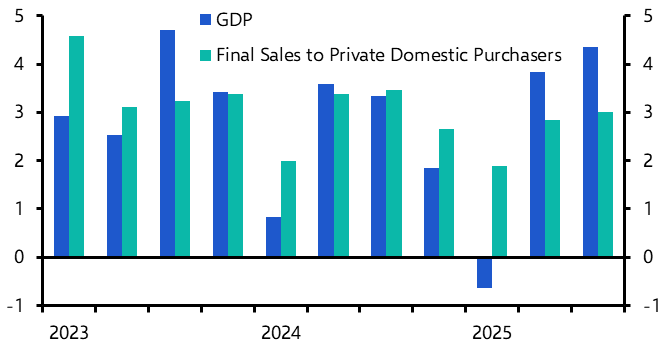Last week we launched a new service: ‘The Long Run’. This looks beyond our normal forecast horizon of one to two years ahead and analyses the issues that will shape economic prospects and financial market outcomes over the second half of this decade and beyond. You can find more details here.
Most long-term forecasts rely on models that “revert to trend” over time. This leaves little room for analytical judgement and tends to produce forecasts that project the recent past forward in a broadly straight line. One consequence is that they miss structural changes in economies. It is for this reason that we have long held a very different – and more pessimistic - view than most other forecasters of the long-term growth prospects for emerging economies. This is rooted in a belief that the forces that combined to turbo-charge EM catch-up in the 2000s were largely one-offs and have now faded. The result will be a period of structurally weaker growth.
In contrast, we have been more optimistic about the possibility that new digital technologies might eventually lead to a pick-up in productivity growth in advanced economies. One of the key lessons from history is that it takes time for structures and processes to adapt in order to harness the productivity benefits of new technologies. But once this happens the effects can be both sudden and significant. This is one reason why our long-term forecasts for growth in advanced economies have tended to sit some way above the consensus.
Of all the challenges now facing long-term forecasters the most important is to assess the economic legacy of the COVID-19 crisis. At first sight, the omens are not good. History is littered with examples of economic crises that have been followed by lengthy periods of much weaker growth, often lasting many years and sometimes decades. This has understandably led to fears that a similar fate awaits once the acute phase of the pandemic passes. But we think this time might really be different.
To understand why, it is necessary to understand the reasons why economies can get stuck on a permanently lower path of GDP following a crisis. Three stand out.
The first is that the pre-crisis trend was simply unsustainable. In many cases, the earlier phase of growth was boosted by factors that could not last and very often ended up sowing the seeds of the crisis itself (for example, excessive credit growth). As a result, the post-crisis trend is necessarily lower than the pre-crisis one.
The second factor is that crises can destroy supply potential. Capital is rendered obsolete and high and persistent levels of unemployment cause skills to atrophy. This reduces the capacity of the economy to produce goods and services and lowers the post-crisis growth path.
The final reason is that households and businesses are often forced to repair their balance sheets in the wake of a crisis, thus restraining their spending and resulting in a prolonged period of extremely weak demand. This post-crisis state may in fact not be permanent and demand may ultimately return. But the period of adjustment can still depress growth for several years.
However, none of these factors apply today. GDP growth in many developed and emerging economies had already fallen sharply before the crisis, thus lowering the bar in terms of a path back to “normality”. At the same time, government support schemes have minimised long-term scarring of labour markets. And while some capital stock has been rendered obsolete (airlines, office space and so on), the pandemic is likely to spur investment in new areas, including digital technology. Finally, in contrast to previous crises, household and corporate balance sheets have actually strengthened during the pandemic. The post-COVID world will not commence with a long period of private sector balance sheet repair.
Accordingly, we doubt the pandemic will set the world economy on a permanently lower path of output and depress GDP over the long-term. On the contrary, we think most economies will return to their pre-virus levels of output by next year, and to their pre-virus trends by 2023-24.
Instead, a key point we emphasise on our new Long Run service is that market participants should look beyond GDP to find the long-term effects of the pandemic. One consequence is likely to be much higher public debt burdens - and another decade of negative real interest rates to keep the public finances on a stable footing. If this requires governments and central banks to tolerate a moderately higher rate of inflation then they will do so. Financial repression will become part of the post-COVID market lexicon.
At the same time, the pandemic is likely to accelerate long-term trends in consumer and business behaviours that were already underway before it struck. This includes a shift in the way that we work, live and shop, with significant implications for property markets. At a geopolitical level it will also accelerate US-China decoupling.
All of this will have significant implications for financial markets and decisions about asset allocation. We will be covering all of this in detail on the Long Run - for a trial, click here.
In case you missed it:
- A final plug for our client survey - please take a few minutes to tell us what you think.
- Our Senior Economic Advisor, Vicky Redwood, debunks concerns that QE has made the UK government’s finances more vulnerable to increase in short-term interest rates.
- Our Chief Europe Economist, Andrew Kenningham, weighs into the debate about whether the ECB should write off the sovereign debt now sitting on its balance sheet.
- Our Chief Emerging Market Economist, William Jackson, explains why the EM recovery from the pandemic will look very different from the recovery after the global financial crisis.



